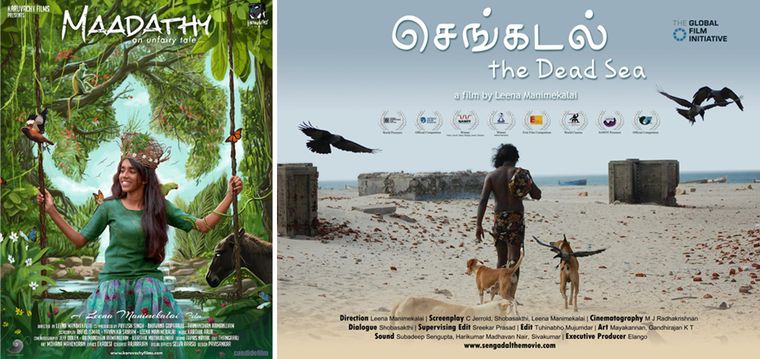Q/ What do you have to say about being targeted for the Kaali poster?
A/ I can hundred per cent vouch that this troll army is well trained by the ruling Hindu fundamentalist party, built brick by brick, oiled well by hate and launched on and off to throttle activists, artists, dissenters and minorities. They are driven neither by faith nor by sentiments. This is not vitriol or outrage. This is organised crime. These 200,000 trolls launched on me are not the real secular Hindus who will dare to slander me, virtually rape me, dehumanise me by morphing my photos doxxed from my social media handles, openly bay for my blood and threaten to kill me. This mob is a bomb thrown by the government to crush everyone who differs with their political programme.
Q/ Is the reaction to the poster a general reflection of the prevailing political climate in India? Did you anticipate such a response?
A/ Kaali is my small academic student project. I made it as a creative piece on multiculturalism in Canada. Tamil poet Subramania Bharathiyar wrote about Kali in ‘Yaathumaagi Nindrai’, which means “Kali, you pervade the universe, you manifest in all objects.” There is a line in that song “Ennulley pugunthaay, pinpu ninnai yallaal kali... pirithu naanum undo”, which translates to, “When you descend upon me, I do not have a separate identity.” I am a spiritual atheist who believes in a spirit that flows among us all and connects everyone and everything on every scale, from minor coincidences to major global changes. I wanted to see the streets of downtown Toronto—the land of immigrants who are actually the settler colonialists—through the eyes of Kali.
Q/ Twitter and the Aga Khan Museum have chosen to play it safe. How does it affect you?
A/ It is the government in the Centre that instructed Twitter to withhold the tweet. It is the Indian High Commission that pressured the institutions into expressing regret for the exhibition of the project. It is sad to see institutions like the Toronto Metropolitan University and the Aga Khan Museum operating in a sovereign country like Canada bowing down to the international enforcement of hindutva’s totalising narrative and relentless quashing of free expression.
Q/ What do you have to say about the decision by the Indian mission in Toronto to get involved in the issue?
A/ Bureaucracy in India is always a mouthpiece of the government. So the press release of the Indian High Commission is not a surprise to me. They give out a message that their diplomacy also is Hindu fundamentalism and there is no place for academic or artistic freedom. In fact, hindutva has been rhetorically violent in silencing academic criticism of Indian politics.
Q/ Mainstream cinema, at least in Tamil, is making more movies on caste issues now. Even Bollywood had an Article 15. What do you think of these efforts?
A/ Periyar’s “self-respect movement” that was built on atheism, anti-caste and feminist politics is fundamental in keeping Tamil Nadu a bullet-proof land to fundamentalism. That plays a major role in the history of modern Tamil art and culture, too. Films telling dalit stories are as early as the film Nandanar (1942) in Tamil. But yes, dalit assertion has been emboldened in recent times.
Q/ Do you think your message gets diluted when it is a feature film rather than a documentary?
A/ I am a documentary junkie. It always fascinates me as the language of storytelling. I have tried fiction and poem films, too. I really don’t decide the genre when I dive into a subject. I just let the process determine my choice of film language.
Q/ You have been making films for about two decades now. You must have faced such criticism before. Has it ever been this bad, though?
A/ My entire filmography and bibliography have strong footprints of constitutional and extraconstitutional censorship. My body is full of scars and bruises earned in the battles for artistic freedom. The BJP’s abolition of the tribunal (Film Certificate Appellate Tribunal) and revision of the Cinematograph Act even without carrying out dialogue with the filmmakers of this country is a death knell to freedom of expression. Without FCAT, both my features would not have seen the light without a single cut. I do not know the future of political filmmaking in India. It feels like the end of the world. Look what happened to Kaali. The Central government itself behaves as a mega fringe element. I wonder how to constitutionally fight for free expression. Nobody deserves this sledge of hate and filth in order to make art.
Q/ Do you think films play an important role in telling people the differences in society? How do you think your films impact people?
A/ I am interested in participatory filmmaking. I am constantly decoding the hegemony of authorship. I see film as a beautiful instrument of dialogue between artists and communities whose stories are told, between artists and viewers, between viewers and communities, and so on. I am more a process person than an end-product person in terms of art practice.
Q/ How did the audience react to your films Maadathy and Sengadal?
A/ Distribution is the bottleneck for the indies. Both Sengadal and Maadathy experimented with viewers’ participation through various forms of crowd-funding and community participation; they were involved in both creative and production processes. My censorship battles are driven by my belief in the artist’s right to make a film and the audience’s right to watch the film without state censorship. I legally fought to exhibit my films without a single cut. Why do you think I am still alive and fighting back? It is the love of my audience and the extreme satisfaction I get in the life-altering journey with every single film that keep me going.


